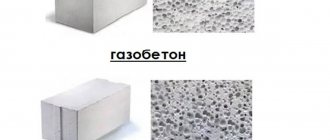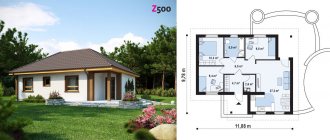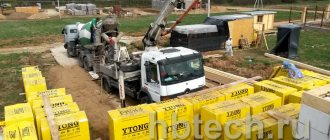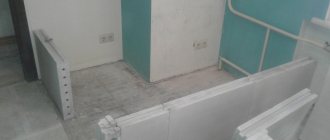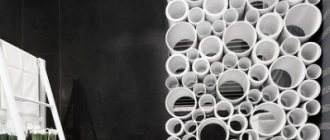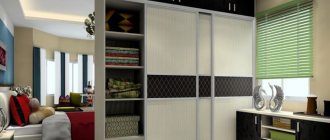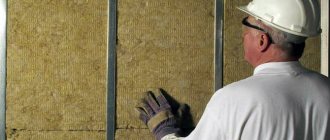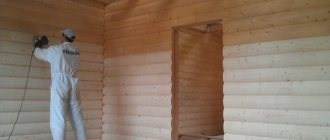In the modern world, quality of life, environmental friendliness of materials, and comfort in the home are becoming increasingly important. If previously any materials (aerated concrete, AGP, and others) were used for internal walls and partitions, guided by savings, now more and more often clients are investing in their comfort and health by choosing ceramic blocks. They serve two main functions:
- Interior partitions (apartment, office, house, etc.)
- Internal load-bearing walls of the house
Let's consider each item separately below to make it easier for you to decide on the choice of material. We will cite the products of ]Wienerberger[/anchor] as an example, since they have the most complete and high-quality line of partition blocks.
Conscious need for poration
Mankind discovered houses made of warm ceramics thanks to the energy crisis of the 70s of the last century. Energy prices soared then that many people chose to turn off the heating altogether. Scientists were desperately trying to come up with a material for walls that would retain heat indoors, and engineers from Australia succeeded. They invented ceramic blocks for construction with a large number of voids inside. Air does not conduct heat well, and the more voids there were in the ceramic blocks, the warmer the walls made from them turned out.
The first blocks contained up to 53% air. How this was achieved: sawdust was added to the clay from which the blocks were made (then they were replaced with other porous additives). During the firing of the blocks, the sawdust burned out and voids formed in their place. The structure of the blocks ensured their low thermal conductivity, but this was not enough. To achieve the standard thickness of the outer walls of the blocks, engineers went beyond the standard brick dimensions and increased them several times. But here a new problem appeared: during construction, walls made of large ceramic blocks connected with mortar turned out to be less reliable than walls made of ordinary bricks. And then one side of the block began to be made in the form of tongue-and-groove joints.
Paveltmk FORUMHOUSE Member
We are building a house from blocks, very light, one weighs about 16 kilograms, they fit together clearly. The size of a block is approximately fourteen bricks - this speeds up the construction process significantly.
The first houses from such blocks were built in the early 80s, then the fashion for blocks spread throughout the planet, and in the late 90s the first manufacturing plant of this material appeared in our country. planet, and in the late 90s the first manufacturing plant of this material appeared in our country.
Major manufacturers of ceramic porous blocks
Warm ceramics are a guarantee of quality and reliability. In addition to the fact that the Wienerberger ceramic block allows you to build ready-made walls, fakes are widespread on the construction market. The brick manufacturer Wienerberger takes a very careful approach to the production of its products. Porous stone is made from environmentally friendly raw materials of natural origin: clays and loams, with the addition of sand and porous agents - sawdust, shavings, rice husks.
The manufacturer Gzhel Brick Factory has existed for more than seventy years. The Gzhel plant produces high-quality wall ceramics at low prices, due to the fact that the plant is located near clay deposits.
| Name of characteristic (indicator) | Meaning and comments |
| Thermal conductivity | 0,1-0,2 |
| Frost resistance | From 50 cycles |
| Wall thickness | From 0.6 m |
| Water absorption | No more than 10% |
| Strength grade | 75 |
Ceramic blocks according to GOST
Modern ceramic blocks have changed greatly compared to the Australian invention: they contain up to 72% air, and the dimensions of standard bricks are 2.1 - 14.9 times larger. Depending on the size, both load-bearing walls and partitions are made from them.
The more porous additives there are in the clay, the higher the thermal characteristics of the blocks, but the lower the strength. Light and at the same time durable blocks can only be made with very good and sophisticated equipment, so you need to take the choice of manufacturer seriously. The interstitial walls of the blocks must be super-thin, and this can only be achieved by crushing additives and rocky inclusions in the clay into fibers. At the first stage, clay with additives sequentially passes through several roller crushers; in each subsequent one, the gaps between the rollers are reduced until they reach 0.7 mm. Then, after a series of manipulations, blocks with voids inside are formed from the mixture, pressed, dried for a long time at a temperature that gradually increases from 30 degrees to 110 degrees and fired in an oven.
The production of ceramic blocks is regulated by GOST 530-2012 “Ceramic brick and stone”. The document describes different standard sizes of ceramic blocks, from which walls with a thickness of 250 to 510 mm can be laid. The dimensions of the blocks are indicated relative to ordinary building bricks: NF is a normal format, 250x120x65 mm. A block equal in size to 2.1 bricks is called 2.1 NF.
Here are the most popular sizes on the market:
- 10.7 NF (38th), 380x250x219 mm.
- 12.4 NF (44th), 440x250x219 mm.
- 14.3 NF (51st), 510x250x219 mm.
The sizes of blocks from different manufacturers may differ by a couple of millimeters. There are also additional blocks for corners and openings. It is preferable to use them rather than sawing large ones.
GOST does not allow product deviations from the nominal dimensions in length by 10 mm, width by 5 mm, and thickness by 4 mm.
The thickness of the outer walls according to GOST should always be 8 mm or more. The strength of the block should be M25-M175, but there are products with strength from M200. GOST does not regulate the water absorption of ceramic blocks, but on average it is 10-15%.
Buildings made from such blocks fully comply with SNIP adopted in Russia.
WinderFORUMHOUSE Member
You can build load-bearing walls of 3 floors, if necessary. The strength of masonry made from such blocks on M100 mortar is about 1.2 MPa (12 kg/cm2 or 120 tons/m2). For comparison, the strength of masonry made from ordinary M100 bricks on M100 mortar is 1.8 MPa (18 kg/cm2).
Ceramic partition. Part one - arguments “FOR”.
Manufacturers of large-format ceramic blocks, along with “warm” wall blocks, offer to purchase non-load-bearing partitions from them. Typically, such blocks come in three sizes:
1) Thin, 8 mm thick;
2) Medium, 10 mm thick;
3) and half-brick blocks, 12 mm thick.
Let's look at all the pros and cons of ceramic partitions.
1. The main argument in favor of a ceramic partition is its large size (510 mm long and 219 mm high), which allows you to build interior walls very quickly, 3-5 times faster than similar ones made of brick. A significant advantage, especially for developers who need to complete large volumes of work in a limited period of time.
2. The second advantage is the noise insulation obtained when using them. Ceramic partition blocks have excellent sound insulation and noise reduction parameters. So, with a noise standard of 43 dB for interior partitions, a 12mm block has a sound insulation of 47-48 dB, and an 8 mm block has 43-46 dB, depending on the manufacturer.
3. The advantages of ceramic partitions include their strength. A partition made of ceramic blocks, for example, cannot be punched with a fist, like drywall, or picked out with a knife, like aerated concrete. The standard strength grade for ceramic partition blocks is M100.
4. Water absorption of the ceramic partition does not exceed 16%. Thanks to these indicators, it is ideal for rooms with high humidity, for example, basements, saunas, car washes, bathrooms.
5. Ceramic partitions have excellent normal adhesion strength, an average of 0.26 MPa, which is 3 times better than aerated concrete. Those. Plaster is ideally placed on ceramic blocks and tiles are glued.
Dimensions of ceramic blocks
Ceramic blocks are also used as insulation (their strength grade is M30-M50), and for the construction of load-bearing walls, blocks with a strength of M100 or higher are needed. They are made by adding special mineral additives to the clay.
Alexey Ektb FORUMHOUSE Member
If the blocks are standard, and not some test or discounted ones, then their safety margin is enough to allow you to lay floor slabs without any armored belt.
But such durable blocks have higher thermal conductivity, so walls made from them are lined with material with good heat-insulating properties.
UrailFORUMHOUSE Member
Any porous ceramic requires an external lining to protect the masonry from adverse weather conditions.
Very often, houses made of warm ceramics are built according to a combined scheme:
- the inner layer is made of durable ceramic blocks (this is about 60-70% of the wall thickness). Such blocks are selected based on the standard thickness of the supporting layer: 25, 38, 44 or 51 cm.
- The next layer is a layer of thermal insulation (20-30%),
- Then comes the outer cladding of half a brick made of low porosity brick (porosity is no more than 30%). The thickness of the cladding layer can be 8, 12 and 20 cm.
The strength of such a classic three-layer wall is equal to the strength of a pillar of 2.5 bricks of grade 100. And its thermal conductivity corresponds to the thermal conductivity of a 60-80 centimeter wall made of hollow brick.
Both masonry and facing blocks are laid only in a certain direction, connecting them with tongue and groove sides.
In practice, in Moscow and other cities and regions with a temperate climate, walls made of ceramic blocks 40 cm thick or more are not additionally insulated; only cladding and a plaster facade are used.
And this, judging by the reviews, is one of the main reasons for their popularity.
RomanF67FORUMHOUSE Member
I was building a house for a large family, three floors plus a garage complex. The house according to the project is large, has an impressive budget, and we spent a long time choosing materials with the customer. Ceramics are quite expensive, but we figured that if we spend more on materials now, we’ll definitely save on construction: ceramics don’t require so much mortar, and there’s no need for additional insulation with mineral wool. The cost of the house was within budget.
In Siberia, houses made of warm ceramics without insulation are built from blocks with a thickness of 51 cm. In the South, the best choice would be a 38th ceramic block.
Types and sizes of ceramic blocks, calculation of the required quantity
Ceramic blocks (porous blocks, warm ceramics) are a unique building material that meets current environmental standards. A ceramic block is a stone with micropores and special voids inside. Its use can significantly reduce the construction time of a house while maintaining excellent performance characteristics.
The article contains information about the types and sizes of ceramic blocks and their manufacturers. Typical calculations of the amount of material required to build a house are given.
Advantages of a house made of ceramic blocks
Houses made from ceramic blocks are most valued for their warmth. The thermal conductivity of the walls is no more than 0.22 W/m˚C, and in most regions of Russia they do not need to be further insulated.
CrewFORUMHOUSE Member
Built from warm ceramics. The heating system has fully justified itself; additional insulation means an increase in the cost of the estimate, which will not pay off. If you want to insulate, then lay one and a half bricks and don’t worry about cold bridges, then top it all with mineral wool and a wet façade.
VegasFORUMHOUSE Member
I was built from block 38, +10 cm of insulation +2 cm ventilation gap and facing with ceramic bricks. Now I would definitely do it without any insulation and ventilation gaps. It’s better to make the plaster thicker later - the price is a penny.
Houses made of ceramic blocks have other advantages:
- Due to the large dimensions of ceramic blocks for construction, walls made from them are built approximately 2.5 times faster than from brick.
- The density of a porous ceramic block is comparable to the density of dry wood (760–850 kg/m3), they are light - the heaviest block weighs less than 17 kg, which means that the house does not require the construction of a high-strength foundation.
- Such houses have excellent sound insulation, especially if they are built from blocks in which the voids are filled not with air, but with basalt insulation.
- Ceramic blocks are not flammable at all.
- They allow steam to pass through just like wood. Therefore, many note that houses made of warm ceramics always have a favorable microclimate.
- Laying method. Vertically, the blocks are joined using a tongue-and-groove pattern, and these vertical seams are not sealed at all, and this also saves money. But there is a danger here: if the work technology was not followed and the blocks are laid unevenly, then the seams will blow out.
WIENERBERGER carries out technical supervision at sites
Question for the professionals. What material is best to use for interior partitions in an apartment? The walls are complex, straight + radius. Drywall is absolutely not acceptable. Sliding and cashless doors are expected, on one of the walls there will be a plasma panel and a hanging cabinet for a sink 1-1.2 m wide
How problem-free will a 100mm foam block be (in terms of strength and hanging heavy objects), or is it better to consider other options? If yes, which ones?
It can only be securely fixed into a foam block using a chemical anchor. In principle, this is not a problem. The material is undoubtedly good, but very hygroscopic. There is no place for foam blocks in the bathroom. It’s good to use moisture-resistant PGP in the bathroom, but even chemical anchors won’t hold in them. You can hang something heavy on them only with a through fastening. In terms of strength, brick certainly rules, but there is a lot of hassle with it, which is not always justified. Personally, I am a supporter of “plasterboard” partitions (by the way, not only gypsum boards can be sheathed with them). GCRs are usually not liked by those who have not seen a correctly installed partition using Knauf technology and materials.
Disadvantages of houses made of ceramic blocks
The main disadvantage of ceramic blocks is their fragility.
- The outer walls of the blocks are thin, and the walls that define the voids are super thin. This material requires careful handling; it cannot be transported, loaded and unloaded at random.
- And the fastening capacity of the blocks is also low. On our portal you can find stories about how all the wall-mounted kitchen cabinets in the house from this material became floor-mounted. It’s true that block walls do not hold standard dowels, but this problem is easily solved with chemical anchors and fasteners for cellular concrete (which are more expensive than standard dowel fastenings). Although some of our users claim that if you drill blocks in a non-impact mode and with a Victory drill, avoiding excessive pressure, then any plastic dowels will hold on like a glove.
- Ideally, it is recommended to scrape walls for laying communications by hand, with a hammer and chisel. As a last resort, use wall cutters or angle grinders. The preforator in crushing mode can destroy blocks.
- Ceramic blocks absorb moisture perfectly, this must be taken into account. It is the high hygroscopicity that leads to cracks running through the blocks. Therefore: a mandatory layer of waterproofing between the foundation and the first row of masonry, protecting the wall from precipitation during construction and storing the material indoors.
- For a house made of ceramic blocks, the qualifications of the builders are very important. Not all masons know how to lay ceramic blocks; in some regions of our country it is impossible to find such specialists.
The installation technology is easy to break, and this leads to the formation of cold bridges and freezing of the walls. A house made of warm ceramics will be a damp and cold house. This is evidenced by reviews from people who have experience interacting with such builders.
GalenaForumHouse Member
Not all masons can lay large-format stones correctly. You need to use warm masonry mortar and carefully monitor how ceramic blocks are laid, especially in the corners of the house. Think in advance about how the stones will be cut so that you get even cuts and thus avoid cold bridges in the masonry.
Porizovka houses grow so quickly that builders sometimes do not meet the deadlines for the walls to gain the required strength and immediately install ceilings on them. Therefore, shrinkage of walls made of warm ceramics may also exceed permissible values.
Dismantling partitions made of ceramic blocks.
Removing the partition was not as easy as I thought. The construction turned out to be very durable. Dismantling took almost an hour with a hammer drill, despite the area being only 4.5 square meters. It would be impossible to do the job without a hammer drill.
After dismantling, a partition was erected in the same place on a plasterboard frame. Sound transmission through it is much less and the load on the floor is also much less. Therefore, I don’t regret at all what I did.
